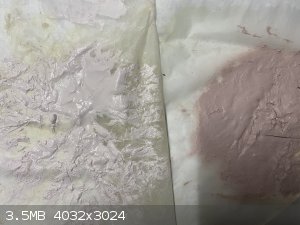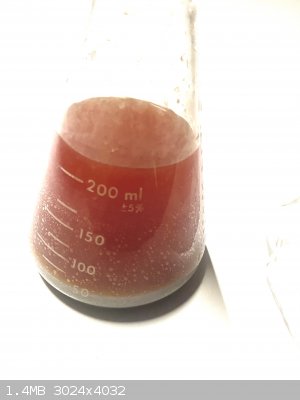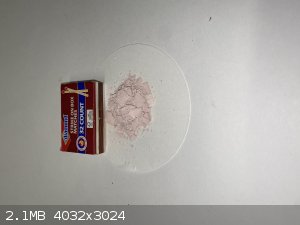Delta-R
Harmless

Posts: 16
Registered: 6-5-2018
Member Is Offline
|
|
Pink Lead Azide... What happened?
So as the title said, my latest Lead Azide synth ended up with a light to medium pink precipitate and an orange filtrate, as opposed to the normal
whitish grey precipitate and clear filtrate.
I’ve used the same reagent grade sodium azide for a while now, stored properly sealed in a lightproof HDPE media bottle - 6.5g or 0.1M in 16ml
H₂O for an approximately saturated solution. The Lead Nitrate was a 1g/ml solution, ~17ml/17g/0.05M worth - I made it a month ago from lead and
dilute HNO₃. Usually I evaporate off the liquid and crystallize out the Pb(NO₃)₂ but this one I just left in solution, titrated it and diluted
down to ~1g/ml, and sealed in a media bottle.
On mixing, the precipitate was instantly a pinkish orange. As I started to filter I got a definite whiff of a very pungent smell - very much acetic
anhydride like, both in its intensity and actual smell, despite the mixing and filtering taking place in a fume hood (though open pretty wide) -
Hydroazotic acid was my immediate supposition, so I took a wash bottle of NaOH solution and added it to the filter flask, shut the cabinet and
GTFO’d.
Anyway, after I checked the Lead Nitrate solution pH against a fresh 1g/ml solution from solid Pb(NO₃)₂ and it is definitely more acidic, around
1-2 vs 2-3 for the fresh. I decided to try a run with the fresh solution and while it was much better, there was still a definite pinkish orange
noticeable.
It’s difficult to tell the colors from the pictures but the fresh run is on the left, the first run on the right. Also the picture of the filtrate
is after the NaOH has gone to town on it so it’s much darker than it was to start but it gives you an idea anyway.
Any ideas on what the discoloration is, side reactions, thoughts?
 
|
|
|
Tsjerk
International Hazard
    
Posts: 3022
Registered: 20-4-2005
Location: Netherlands
Member Is Offline
Mood: Mood
|
|
I recognize that color from when I used to make HE's. Mine was not that strong but it is the same color. What is the source of your lead? Mine was
questionable to say the least.
|
|
|
ordenblitz
Hazard to Others
  
Posts: 259
Registered: 18-7-2004
Location: Northwest
Member Is Offline
Mood: Bohr'd
|
|
My thoughts are.. if you've ever had some of this go of in your face, you might think about making smaller batches.
|
|
|
Delta-R
Harmless

Posts: 16
Registered: 6-5-2018
Member Is Offline
|
|
So you’re right @TSjerk, the lead is fishing weight grade. That was the conclusion I’ve come to myself - the color must be from some other metal
Azide - checked the same lead nitrate with a different source of NaN₃ and the color was the same (which it’s not that saturated IRL, just adjusted
the picture to make it clear). Also checking under magnification, it seems as though the color is mostly in solution. The precipitate is normal grey
white. So I’ve been searching through different candidates for a water soluble azide by narrowing the search to common lead alloying metals but
haven’t reached a definite conclusion yet.
ETA: also, forgot to mention but in a direct side-by-side comparison with a non-discolored sample, there doesn’t seem to be any detectable change in
sensitivity to flame, impact, or friction.
@ordenblitz, we’re definitely on the same page, that’s actually less than 10g NaN₃ with a ton of excess water - the picture is of the raw yield
of the original and 2nd test run combined for a sense of scale. It looked like more due to my giving it a swirl to to get the best picture so it
hadn’t settled yet.
But that’s not to say that 10g doesn’t need to be treated with respect - I’ve been using the safety protocols laid out in a journal article on
HgN₃ crystallization for a while now - leather apron and gloves, face shield, earplugs, lexan shield in front of the fume hood, etc., which is
probably way overkill since I’m not crazy enough to ever attempt to work with anything nearly as sensitive as HgN₃ especially in quantity, but you
only get one chance so better safe than sorry.

[Edited on 15-12-2020 by Delta-R]
|
|
|
woelen
Super Administrator
        
Posts: 7977
Registered: 20-8-2005
Location: Netherlands
Member Is Offline
Mood: interested
|
|
Might be traces of copper azide. Copper azide is dark red/brown. I once made that by mixing a solution of CuSO4 and NaN3. It is very dangerous stuff,
more sensitive than Pb(N3)2.
|
|
|
Bert
Super Administrator
        
Posts: 2821
Registered: 12-3-2004
Member Is Offline
Mood: " I think we are all going to die. I think that love is an illusion. We are flawed, my darling".
|
|
Fishing weights = recycled Lead. Anything capable of being melted having been mixed into such alloys is possible. In rough order of probability:
Antimony, Tin, Arsenic (used to increase hardening speed after casting), Zinc, Copper...
Rapopart’s Rules for critical commentary:
1. Attempt to re-express your target’s position so clearly, vividly and fairly that your target says: “Thanks, I wish I’d thought of putting it
that way.”
2. List any points of agreement (especially if they are not matters of general or widespread agreement).
3. Mention anything you have learned from your target.
4. Only then are you permitted to say so much as a word of rebuttal or criticism.
Anatol Rapoport was a Russian-born American mathematical psychologist (1911-2007).
|
|
|